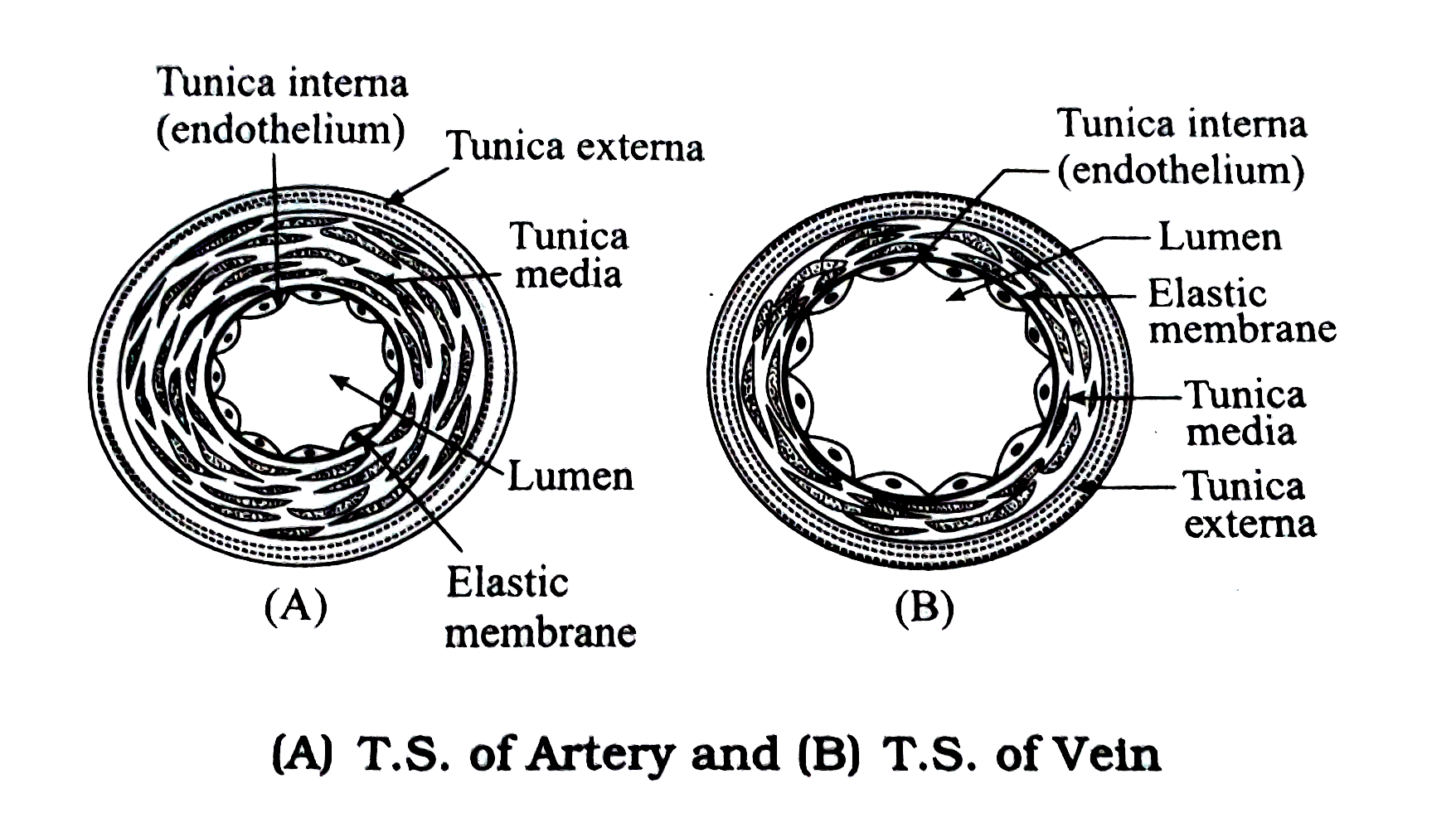Distinguish arteries from veins.
Step-by-Step Solution to Distinguish Arteries from Veins
1. Definition and Function:
- Arteries: These are blood vessels that carry blood away from the heart to various parts of the body. They transport oxygenated blood (except for the pulmonary artery, which carries deoxygenated blood to the lungs).
- Veins: These are blood vessels that carry blood back to the heart from the body. They transport deoxygenated blood (except for the pulmonary vein, which carries oxygenated blood from the lungs to the heart).
Hint: Remember that arteries "exit" the heart, while veins "return" to the heart.
2. Structure:
- Arteries: They have thick, muscular walls that can withstand high pressure as the blood is pumped from the heart. The walls are made up of three layers: the tunica intima, tunica media (thickest layer), and tunica externa.
- Veins: They have thinner walls compared to arteries and are less muscular. The walls are also made up of three layers, but the tunica media is much thinner.
Hint: Think of arteries as strong pipes that need to handle pressure, while veins are more flexible and thinner.
3. Presence of Valves:
- Arteries: They do not have valves because the high pressure from the heart keeps the blood flowing in one direction.
- Veins: They contain valves that prevent the backflow of blood, ensuring that it moves towards the heart.
Hint: Valves are like one-way doors; they are present in veins to keep blood moving in the right direction.
4. Blood Pressure:
- Arteries: Blood pressure in arteries is high due to the forceful pumping of blood from the heart.
- Veins: Blood pressure in veins is lower compared to arteries, as the blood is returning to the heart.
Hint: Remember that arteries deal with high pressure while veins operate under lower pressure.
5. Color of Blood:
- Arteries: Generally, arteries carry bright red oxygenated blood.
- Veins: Veins carry darker red deoxygenated blood.
Hint: Bright red for arteries and darker red for veins can help you visualize the difference.
Summary
- Arteries: Carry blood away from the heart, thick walls, no valves, high pressure, and usually carry oxygenated blood.
- Veins: Carry blood back to the heart, thinner walls, have valves, low pressure, and usually carry deoxygenated blood.
- Arteries: These are blood vessels that carry blood away from the heart to various parts of the body. They transport oxygenated blood (except for the pulmonary artery, which carries deoxygenated blood to the lungs).
- Veins: These are blood vessels that carry blood back to the heart from the body. They transport deoxygenated blood (except for the pulmonary vein, which carries oxygenated blood from the lungs to the heart).
- Arteries: They have thick, muscular walls that can withstand high pressure as the blood is pumped from the heart. The walls are made up of three layers: the tunica intima, tunica media (thickest layer), and tunica externa.
- Veins: They have thinner walls compared to arteries and are less muscular. The walls are also made up of three layers, but the tunica media is much thinner.
- Arteries: They do not have valves because the high pressure from the heart keeps the blood flowing in one direction.
- Veins: They contain valves that prevent the backflow of blood, ensuring that it moves towards the heart.
- Arteries: Blood pressure in arteries is high due to the forceful pumping of blood from the heart.
- Veins: Blood pressure in veins is lower compared to arteries, as the blood is returning to the heart.
- Arteries: Generally, arteries carry bright red oxygenated blood.
- Veins: Veins carry darker red deoxygenated blood.
- Arteries: Carry blood away from the heart, thick walls, no valves, high pressure, and usually carry oxygenated blood.
- Veins: Carry blood back to the heart, thinner walls, have valves, low pressure, and usually carry deoxygenated blood.
Topper's Solved these Questions
- BOOK - PEARSON IIT JEE FOUNDATIONCHAPTER - LIFE PROCESSES IN HUMAN BEINGS - II (RESPIRATORY AND CIRULATORY SYSTEMS)EXERCISE - ASSESSMENT TESTS31videos
LIFE PROCESSES IN HUMAN BEINGS - II (RESPIRATORY AND CIRULATORY SYSTEMS)
- BOOK - PEARSON IIT JEE FOUNDATIONCHAPTER - LIFE PROCESSES IN HUMAN BEING-I (DIGESTIVE AND EXCRETORY SYSTEMS)EXERCISE - ASSESSMENT TESTS (ANSWER THE QUESTIONS)7videos
LIFE PROCESSES IN HUMAN BEING-I (DIGESTIVE AND EXCRETORY SYSTEMS)
- BOOK - PEARSON IIT JEE FOUNDATIONCHAPTER - LIFE PROCESSES IN PLANTSEXERCISE - ASSESSMENT TESTS (ANSWER THE FOLLOWING QUESTIONS)14videos
LIFE PROCESSES IN PLANTS
Similar Questions
Knowledge Check
- Question 1 - Select One
An artery can be distinguished from a vein in having
AThicker wallBLesser lumenCNo valvesDAll of the above - Question 2 - Select One
An artery can be distinguished from a vein in having
AThicker wallBLesser lumenCNo valvesDAll of the above - Question 3 - Select One
The artery can be distinguished from the vein in having
AThicker wallsBThinner wallsCMore plasmaDLarger cavity
Describe double circulation in human beings.
(a) Why is it necessary ?
(b) How are arteries different from veins ?View SolutionList three differences between arteries and veins.
View SolutionThe arteries differ from veins in having :
View SolutionThe blood flows strictly by a fixed route through blood vessels, the arteries and veins. Basically, each artery and vein consists of three layers. Which of the following layer consists of smooth muscles elastic fibres?
View SolutionSplenic artery arises from
View Solution


